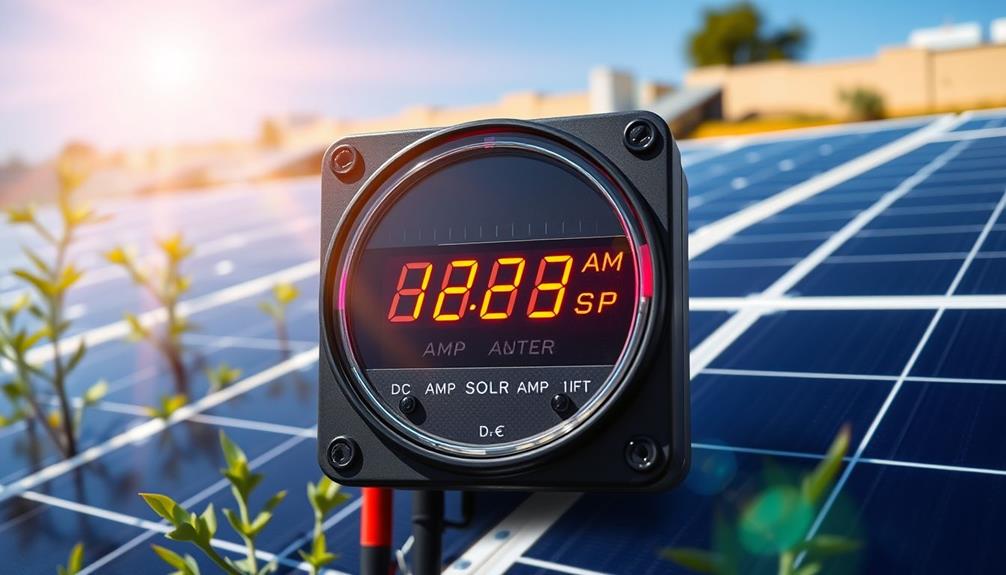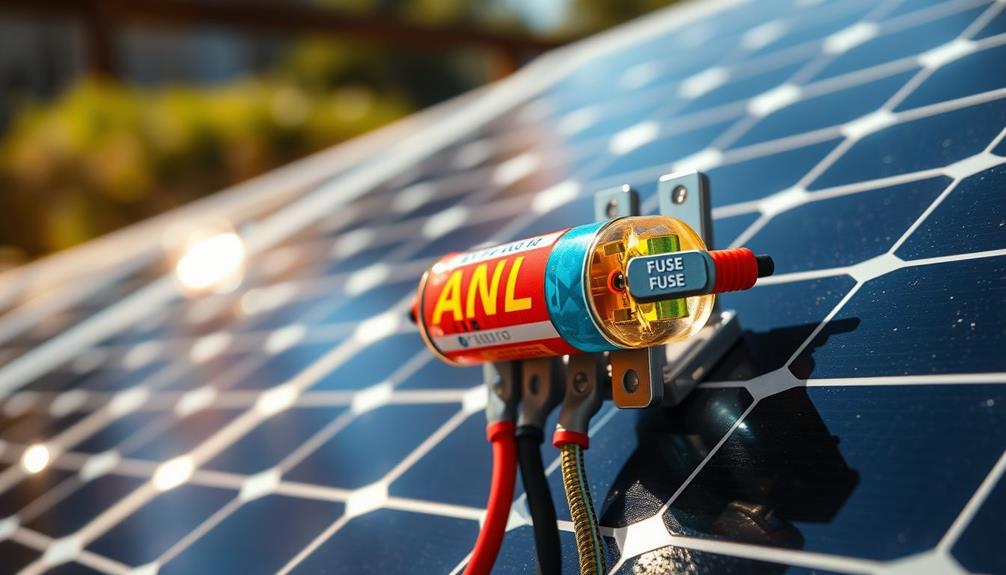A DC Amp Meter is an essential tool to monitor your solar power system effectively. It helps track current flow, ensuring your system operates efficiently and within ideal parameters. With real-time data insights and features like precise voltage and current measurements, you can identify underperforming panels and make informed adjustments. Its user-friendly display and alarm functions keep you informed of any issues that arise. Regular use will help enhance your system's performance and reliability. By understanding how to optimize its capabilities, you can maximize your solar energy investment even further. There's much more you can discover about enhancing your setup.
Key Takeaways
- A DC Amp Meter measures direct current in solar systems, essential for monitoring energy production and consumption effectively.
- It provides real-time data monitoring, helping identify underperforming solar panels and optimize system performance.
- The device features high measurement accuracy using Hall Effect sensors, ensuring reliable readings for informed decision-making.
- With user-friendly interfaces, DC Amp Meters display critical data points and include alarm functions for voltage and current exceedances.
- Data retention during power loss allows for continuous monitoring and supports long-term performance analysis of solar systems.
What Is a DC Amp Meter?

You might be wondering what a DC amp meter is and why it's significant for solar power systems. A DC amp meter is a device specifically designed to measure the direct current (DC) flowing through your solar system's circuit. This measurement is vital for monitoring both energy production and consumption, helping you enhance the efficiency of your setup.
By tracking the current, you can guarantee that your solar system operates within ideal parameters, contributing to your overall renewable energy goals and grid stability, much like how electricity production from wind turbines is maximized through effective monitoring.
With the ability to measure current up to 200A and voltage levels from 0-300V, a DC amp meter provides essential data that enables you to track your solar system's performance effectively. Many models also include cumulative energy tracking, allowing you to gauge your total energy usage over time. This feature can be particularly beneficial for understanding your energy needs and identifying any potential issues.
DC amp meters often use Hall effect sensors for isolated and accurate measurements, guaranteeing both safety and precision in your readings. By utilizing a DC amp meter, you can pinpoint performance issues in your solar power systems, empowering you to make informed decisions regarding maintenance and enhancement.
Ultimately, this tool is fundamental for maximizing the benefits of your solar investment.
Key Features of DC Amp Meters

When choosing a DC amp meter, you'll want to focus on measurement accuracy and precision, as these features directly impact your solar system's performance monitoring.
Understanding your investment goals when selecting a meter can help you maximize efficiency and effectiveness.
A user-friendly interface design makes it easier for you to access real-time data without any hassle.
Understanding these key features guarantees you select a meter that fits your needs effectively.
Measurement Accuracy and Precision
Accurate measurement is vital for optimizing solar power systems, and DC amp meters excel in this regard. These devices, like the DROK Voltage Amp Meter, deliver precise readings of current up to 200A and voltage up to 300V, helping you monitor the performance of solar systems effectively.
Utilizing Hall effect sensors, these meters provide isolated measurements, which enhances measurement accuracy and minimizes electrical interference during readings. To guarantee that your investment is protected, it's wise to avoid scams associated with solar products and equipment.
Users often find that the readings from DC amp meters closely align with professional-grade equipment, such as Fluke Digital Multimeters, confirming their reliability. This level of accuracy is vital for maintaining the efficiency of your solar setup. Calibration plays a significant role in guaranteeing measurement accuracy; many meters allow you to set a reasonable amp-hour (OAH) value for precise calculations.
Regular monitoring and testing of your DC amp meter can help identify discrepancies in readings. By doing so, you can optimize the performance of solar panels and improve energy generation efficiency.
With a reliable DC amp meter in hand, you can confidently manage and enhance your solar power system, guaranteeing you get the most out of your investment.
User-Friendly Interface Design
User-friendly interface designs are a hallmark of modern DC amp meters, ensuring users can easily access and interpret essential information. One significant feature is the full-angle LCD screen, which enhances visibility in various lighting conditions, allowing you to read measurements at a glance.
With many models offering backlight control, you can adjust the brightness based on your preference or the surrounding light, further improving readability. These meters often incorporate intuitive layouts similar to those found in thematic coherence in album structures, making it easier for users to focus on critical data points.
Intuitive interfaces typically provide straightforward navigation for setting parameters, although some users might find specific settings under-documented, leading to occasional confusion. To help mitigate this, user-friendly designs often incorporate visual alarms for voltage and current thresholds, alerting you to potential issues in real-time.
Additionally, enhanced readability through larger font sizes for key metrics, like battery percentage and amp-hour readings, makes it easier to monitor your solar power system without straining your eyes.
Real-Time Data Monitoring
Real-time data monitoring is vital for optimizing the performance of your solar power system, and DC amp meters excel in this area. These meters provide instant insights into the current flow, enabling you to track how much energy your solar panels produce or consume. Most models can measure bidirectional current up to 200A, guaranteeing you get accurate readings that reflect your system's true performance.
Additionally, the presence of effective monitoring solutions can greatly enhance your overall safety and efficiency, much like the way home security systems deter potential threats.
With features like backlit displays, you can easily read the data, regardless of lighting conditions. This convenience means you won't miss important information while managing your system. Additionally, many DC amp meters come with alarm functions that notify you when voltage or current exceeds preset thresholds, helping you detect potential issues before they escalate.
Moreover, these meters boast data retention capabilities, so your accumulated electric energy readings remain preserved even during power interruptions. This reliability guarantees you can always monitor your system effectively, making it easier to make informed decisions about your solar power usage.
Benefits of Using a DC Amp Meter

Using a DC amp meter lets you monitor energy flow in real-time, helping you quickly spot any underperforming panels.
This immediate feedback is essential for optimizing your solar system's performance, especially in a tiny house where energy efficiency is paramount.
Additionally, maintaining a minimalist lifestyle often means relying on effective energy solutions.
With these insights, you can make informed adjustments that enhance your energy generation efficiency.
Real-Time Energy Monitoring
When it comes to monitoring your solar power system, having a DC amp meter can make all the difference. This essential tool provides real-time data on current flow, allowing you to continuously track the performance and efficiency of your system. Additionally, a DC amp meter can help you identify any potential issues or malfunctions in your solar panels, which is crucial for solar panel safety. By catching problems early, you can prevent any damage to your system and ensure that it continues to operate safely and effectively. With a DC amp meter, you can have peace of mind knowing that you have full visibility into the performance of your solar power system and can address any concerns promptly.
By measuring bidirectional current, the meter helps you identify any discrepancies in energy generation, ensuring peak operation and enabling you to resolve issues promptly. Additionally, understanding cold medications overview can enhance your decision-making regarding energy management, similar to how you'd address health concerns with the right remedies.
With the ability to track accumulated electric energy and remaining capacity percentage, you gain valuable insights into your energy usage and battery health, which aids in maintenance planning. Real-time monitoring enhances your decision-making regarding energy production, helping you maximize your return on investment from your solar panel system.
Moreover, the alarm functions for exceeding voltage and current thresholds alert you to potential problems before they escalate. This proactive approach contributes to the longevity and efficiency of your solar system, allowing you to enjoy the benefits of clean energy without unnecessary interruptions.
Performance Optimization Insights
Monitoring your solar power system isn't just about keeping an eye on performance; it's about optimizing it for maximum efficiency. A DC amp meter gives you real-time data on the current flowing through your system, enabling you to quickly identify underperforming components. By tracking amperage output, you can adjust the orientation and tilt of your solar panels for enhanced energy generation.
Here's how using a DC amp meter can improve your solar power system:
| Benefits | Explanation |
|---|---|
| Real-Time Monitoring | Identifies performance issues instantly. |
| State of Charge Calculation | Manages energy storage effectively. |
| Overcurrent Protection | Prevents damage with built-in alarms. |
| Data Retention | Allows for analysis of energy production trends. |
| Informed Decision-Making | Facilitates upgrades or maintenance planning. |
With accurate measurements of current, you can guarantee your system operates at its best. The insights from a DC amp meter empower you to make data-driven decisions, maximizing both power output and efficiency. Don't just monitor—optimize your solar power system!
Installation and Setup Guide

To guarantee a successful installation of the DROK Voltage Amp Meter in your solar power system, start by connecting the +12VDC power supply and ground to the appropriate terminals. Confirm proper wiring for accurate readings, as incorrect connections can lead to misleading data.
Additionally, consider incorporating energy-saving features that can greatly reduce overall energy consumption, similar to those found in top-rated heat pumps.
Next, for ideal setup, configure the amp-hour (OAH) value based on your battery's specifications. This step is vital for accurate percentage calculations of remaining charge.
Once that's done, you'll need to calibrate the meter. Fully charge your battery to 100% or discharge it to 0%, then reset the State of Charge (SoC) through the menu options to reflect accurate data on the display.
When setting up, utilize the Hall sensor for isolated measurements and choose between two-wire or three-wire connections based on your system requirements.
Be sure to refer to the user manual for specific parameter settings, as some configurations may lack detailed documentation. This can help avoid confusion during setup.
Following these steps will guarantee your DROK Voltage Amp Meter operates effectively, providing you with essential data for managing your solar power system efficiently.
Performance Monitoring With DC Amp Meters

After completing the installation and setup of your DROK Voltage Amp Meter, you're now ready to take advantage of its performance monitoring capabilities. This DC amp meter measures bidirectional current up to 200A, giving you real-time insights into your solar power system's performance.
With the increasing demand for renewable energy solutions, understanding your system's efficiency is more essential than ever, especially as AI software engineer jobs continue to evolve alongside technology. You can easily monitor DC voltage levels and track energy production efficiency, which is vital for optimizing your solar setup.
Equipped with alarms for voltage and current thresholds, your meter enables prompt identification of potential issues that could affect energy generation. If something goes awry, you can act quickly to mitigate any impact.
Plus, the ability to display accumulated electric energy and remaining capacity percentage helps you keep tabs on battery health, ensuring your system runs smoothly.
Many models, including yours, retain data during power loss, providing continuous monitoring even during interruptions. This feature is invaluable for performance monitoring, as accurate readings closely match those from professional digital multimeters.
Troubleshooting Common Issues

Troubleshooting common issues with your DC amp meter is vital for maintaining accurate performance readings in your solar power system. If you notice your State of Charge (SoC) readings consistently display 100%, it's likely time for recalibration or adjustments.
High-quality content boosts credibility and environmental factors, like humidity, can also impact your meter's reliability, so make sure it's suitable for your operating conditions.
Certain models, such as the DROK DC Voltmeter Ammeter, may become unreliable after auto screen-off, sometimes failing to register current. Regular monitoring can help mitigate this issue.
Calibration is essential for accuracy; discharge your batteries to a specific cutoff point and record amp-hour (AH) values to fine-tune your meter's settings.
When you experience sudden discrepancies in readings, it's important to check the shunt's performance. Recalibrating the meter afterward can help maintain accurate measurements over time.
By being proactive in troubleshooting these common issues, you'll enhance your DC amp meter's performance and make certain your solar power system runs efficiently.
Comparing DC and AC Meters

When it comes to monitoring energy in your solar power system, understanding the differences between DC and AC meters is fundamental. DC meters, like the DROK Voltage Amp Meter, measure direct current and voltage output from your solar panels. This makes them essential for tracking the performance of your solar energy system, as they provide real-time data that allows for precise analysis.
In contrast, AC meters measure alternating current, which is typically used in household circuits and doesn't cater to the unique needs of solar energy systems.
The voltage range of DC meters can reach up to 300V and handle current levels up to 200A, making them specifically suited for solar applications. They offer higher accuracy in reading solar energy output, often matching the precision of professional meters like Fluke.
On the other hand, AC meters operate at standard voltages like 120V or 240V, which may not reflect the actual output from your solar panels. Additionally, installing DC meters generally involves simpler wiring, while AC meters often require more complex setups due to household circuit configurations.
Choosing the right meter is important for effective energy monitoring in your solar power setup.
Selecting the Right DC Amp Meter

Selecting the right DC amp meter for your solar power system is essential to guarantee accurate performance tracking and data analysis. First, verify compatibility with your specific solar panel types; this is important for obtaining precise measurements and optimizing performance.
Look for a meter with a voltage range of at least DC 0-300V and a current range of 0-200A to effectively accommodate various solar power systems.
User-friendly interfaces and clear display options should be prioritized, as they enhance data accessibility and simplify monitoring tasks. Additionally, consider features that enable real-time data logging and historical trend analysis. These capabilities will help you assess performance and identify issues quickly.
It's also significant to select a DC amp meter that retains data during power loss. This feature is important for consistent monitoring and accurate performance evaluations of your solar energy system.
Enhancing Solar System Efficiency

To enhance the efficiency of your solar power system, regularly monitoring the current flow with a DC amp meter is essential. By keeping an eye on real-time measurements, you can identify underperforming panels and optimize performance. Tracking ampere hours (AH) helps you assess battery capacity and energy consumption, ensuring you manage your solar energy resources effectively.
Here's a quick comparison of features to evaluate when using a DC amp meter:
| Feature | Benefits | Importance |
|---|---|---|
| Real-time Measurements | Identify inefficient panels | Boosts energy production |
| Ampere Hour Tracking | Monitor battery capacity | Prevents energy waste |
| Voltage/Current Alarms | Protects system from damage | Enhances reliability |
| Data Logging | Analyze historical trends | Informs upgrades and adjustments |
| ROI Improvements | Pinpoints inefficiencies | Maximizes energy production |
Utilizing a DC amp meter not only helps you monitor your system but also allows you to make informed decisions. This proactive approach can lead to improved return on investment (ROI) by allowing you to adjust your setup for maximum energy efficiency.
Frequently Asked Questions
What Type of Meter Do I Need for Solar Power?
You need a DC amp meter that measures direct current output, ideally with a voltage range of 0-300V and current up to 200A. Look for features like real-time tracking and user-friendly interfaces for easy monitoring.
How to Measure DC Amps on a Solar Panel?
To measure DC amps on a solar panel, use a clamp meter set to DC mode. Clamp it around the wire, guarantee a secure connection, and record readings during peak sunlight for accurate results.
What Is the Purpose of the Solar Power Meter?
Imagine you're tracking your solar panel's energy output. A solar power meter helps you monitor that production, ensuring you optimize performance, identify issues, and calculate your investment's return accurately, maximizing the benefits of your system.
How to Test Solar Panel Amp Output?
To test your solar panel's amp output, connect a DC amp meter in series with the panel. Confirm it's under full sunlight for accurate readings, and record results throughout the day to analyze performance variations.
Conclusion
In the world of solar power, a DC amp meter stands as both a simple tool and a crucial lifeline. While it may seem like just another gadget, it connects you to your system's performance, revealing the hidden interplay between energy generation and consumption. By harnessing this essential tool, you not only optimize efficiency but also empower yourself to make informed decisions. In the dance of sunlight and energy, the DC amp meter becomes your guiding rhythm.










